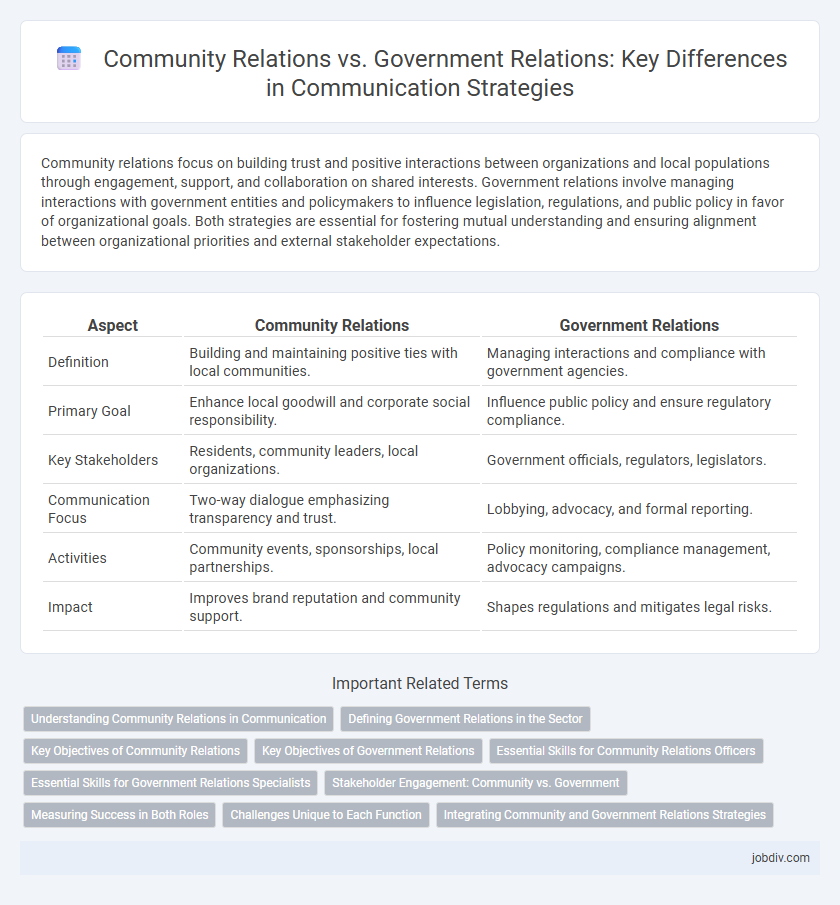Community relations focus on building trust and positive interactions between organizations and local populations through engagement, support, and collaboration on shared interests. Government relations involve managing interactions with government entities and policymakers to influence legislation, regulations, and public policy in favor of organizational goals. Both strategies are essential for fostering mutual understanding and ensuring alignment between organizational priorities and external stakeholder expectations.
Table of Comparison
| Aspect | Community Relations | Government Relations |
|---|---|---|
| Definition | Building and maintaining positive ties with local communities. | Managing interactions and compliance with government agencies. |
| Primary Goal | Enhance local goodwill and corporate social responsibility. | Influence public policy and ensure regulatory compliance. |
| Key Stakeholders | Residents, community leaders, local organizations. | Government officials, regulators, legislators. |
| Communication Focus | Two-way dialogue emphasizing transparency and trust. | Lobbying, advocacy, and formal reporting. |
| Activities | Community events, sponsorships, local partnerships. | Policy monitoring, compliance management, advocacy campaigns. |
| Impact | Improves brand reputation and community support. | Shapes regulations and mitigates legal risks. |
Understanding Community Relations in Communication
Community relations in communication emphasize building trust and mutual understanding between organizations and local populations, fostering collaboration through transparent dialogue and active listening. This approach prioritizes addressing community needs, values, and concerns to create sustainable partnerships that enhance social goodwill. Effective community relations involve targeted outreach, culturally sensitive messaging, and continuous engagement to strengthen communal bonds and support organizational reputation.
Defining Government Relations in the Sector
Government relations in the communication sector involve strategic interactions between organizations and governmental agencies to influence public policy, regulations, and legislation. This function focuses on advocacy, compliance monitoring, and fostering partnerships with policymakers to advance sector-specific interests. Effective government relations ensure that communication companies can navigate regulatory landscapes and contribute to policy development that supports industry growth.
Key Objectives of Community Relations
Community relations focus on building trust and fostering positive interactions between an organization and its local stakeholders through engagement, support, and collaboration initiatives. Key objectives include enhancing reputation, promoting social responsibility, and addressing community needs to create long-term goodwill. These efforts contribute to sustainable development by aligning organizational goals with community interests.
Key Objectives of Government Relations
Government relations focus on influencing public policy, securing regulatory approvals, and fostering partnerships with government agencies to support organizational goals. Key objectives include lobbying for favorable legislation, ensuring compliance with laws, and advocating for resources or funding. Effective government relations enhance an organization's ability to navigate political environments and shape decisions that impact its operations.
Essential Skills for Community Relations Officers
Community Relations Officers excel in stakeholder engagement, cultural sensitivity, and conflict resolution to build trust and foster positive community partnerships. Mastery in effective communication, public speaking, and social media management enhances their ability to convey organizational goals and gather community feedback. Proficiency in local policy knowledge and networking enables seamless collaboration with government entities, distinguishing their role from Government Relations professionals.
Essential Skills for Government Relations Specialists
Government Relations Specialists require expertise in policy analysis, stakeholder engagement, and strategic negotiation to effectively influence legislation and regulatory frameworks. Proficiency in understanding governmental procedures, political landscapes, and compliance requirements ensures successful advocacy and relationship-building with public officials. Strong communication skills, including clear messaging and diplomacy, are essential for fostering trust and collaboration between organizations and government entities.
Stakeholder Engagement: Community vs. Government
Stakeholder engagement in community relations centers on building trust and fostering open dialogue with local residents and interest groups to address social, environmental, and economic concerns. In government relations, engagement targets policymakers and regulatory bodies to influence legislation, secure approvals, and ensure compliance with legal frameworks. Both require tailored communication strategies that prioritize transparency, responsiveness, and mutual benefit to strengthen long-term partnerships.
Measuring Success in Both Roles
Measuring success in community relations is often based on stakeholder engagement levels, sentiment analysis, and the impact on local reputation, while government relations success is gauged through policy influence, regulatory outcomes, and relationship strength with key decision-makers. Community relations metrics include event participation rates, feedback quality, and collaboration frequency with local organizations. Government relations rely on tracking legislative wins, meeting efficacy with officials, and long-term partnerships that advance organizational goals.
Challenges Unique to Each Function
Community relations face challenges such as managing diverse stakeholder expectations and addressing localized social concerns, requiring empathy and cultural sensitivity. Government relations encounter complexities involving regulatory compliance, policy advocacy, and navigating bureaucratic processes that demand strategic lobbying and legal expertise. Both functions require tailored communication strategies to effectively influence and engage their respective audiences while mitigating risks related to public perception and political dynamics.
Integrating Community and Government Relations Strategies
Integrating community and government relations strategies enhances overall communication effectiveness by aligning local stakeholder engagement with regulatory and policy objectives. Collaborative efforts between community leaders and government officials foster trust, streamline advocacy initiatives, and ensure consistent messaging across all platforms. Tailoring communication strategies to address both public interests and governmental priorities drives sustainable development and strengthens organizational reputation.
Community Relations vs Government Relations Infographic

 jobdiv.com
jobdiv.com